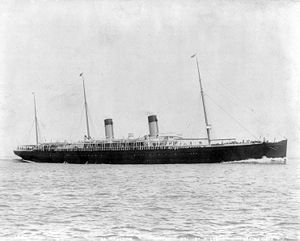RMS Majestic (1889): Difference between revisions
No edit summary |
Rescuing 1 sources and tagging 0 as dead. #IABot (v1.6.1) (Balon Greyjoy) |
||
| Line 123: | Line 123: | ||
==References== |
==References== |
||
*[http://www.du.edu/~tbjokne/rms_majestic.html Historic information on the ''Majestic''] |
*[https://web.archive.org/web/20060920074504/http://www.du.edu/~tbjokne/rms_majestic.html Historic information on the ''Majestic''] |
||
*[http://www.titanic-titanic.com/majestic_1.shtml Majestic I on Titanic-Titanic.com] |
*[http://www.titanic-titanic.com/majestic_1.shtml Majestic I on Titanic-Titanic.com] |
||
Revision as of 13:58, 23 December 2017

| |
| History | |
|---|---|
| Name | RMS Majestic |
| Namesake | Majestic (Big and impressive) |
| Owner | |
| Operator | White Star Line |
| Port of registry | Liverpool, United Kingdom |
| Builder | Harland and Wolff yards in Belfast |
| Yard number | 209 |
| Launched | 29 June 1889 |
| Christened | not christened |
| Completed | 22 March 1890 |
| Maiden voyage | 2 April 1890 |
| Fate | Scrapped; began on 5 May 1914 |
| General characteristics | |
| Class and type | Teutonic class ocean liner |
| Tonnage | 9,965 gross tons |
| Length | 582 feet (177.8 m) |
| Beam | 57.7 feet (17.6 m) |
| Propulsion | Two triple expansion engines powering two propellers. |
| Speed | 20 knots (37 km/h; 23 mph) (design service speed) |
| Capacity |
|
RMS Majestic was a steamship built in 1890 for and operated by the White Star Line.
History
A product of
On 2 April 1890, Majestic left on her maiden voyage from
In 1895, Majestic was assigned a new captain named Edward Smith, later notable as the captain of Titanic. Smith served as Majestic's captain for nine years. When the Boer War started in 1899, Smith and Majestic were called upon to transport troops to Cape Colony. Two trips were made to South Africa, one in December, 1899 and one in February, 1900, both without incident. Another Titanic shipmate served under Smith aboard the Majestic; Charles Herbert Lightoller served as a deck officer for Smith. "Lights" - as he was nicknamed was to be the most senior officer of the Titanic to survive the sinking.

In 1902–1903, the ship underwent a refit, which included new boilers (and consequently taller twin funnels), after which she returned to the Liverpool-New York run. Smith left as captain in 1904 to take on the new Baltic, then the largest ship in the world. In 1905, Majestic suffered a fire in her bunker, but the damage was not significant. In 1907, White Star's main terminal was moved from Liverpool to Southampton and, on 26 June, Majestic sailed from these new facilities for the first time.
When the Olympic entered service in 1911, Teutonic was removed from the New York run and put on Canadian service with the Dominion Line. Likewise when Titanic came on the scene in 1912, Majestic was retired from White Star's New York service and designated as a reserve ship, biding her time at Birkenhead's Bidston Dock. When Titanic met her fate in April, 1912, Majestic was pressed back into service, filling the hole in the transatlantic schedule.
On 17 October 1913, she came to the rescue of the French
